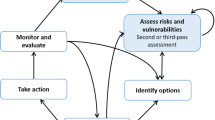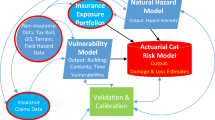Abstract
Community managers and planners have an increasing need for assessing system failure risks as they relate to fact-based information on weather extremes and climate change. We illustrate a model that defines the services a software system can provide to facilitate the discovery of useful information by stakeholders with different technical background wanting to reach a fact-based consensus on risks, hazards, and vulnerabilities. Decision support systems succeed in facilitating the analysis of past severe weather events but provide limited support for the analysis of hazards related to climate change. Severe weather data enable estimates of the ability of an exposed system to withstand environmental extreme values, but the estimates of their impact on communities remain largely undetermined and prone to divergent interpretations. This study proposes a model that is built on the experience of a decision support system (DSS) that is dedicated to guide users through a stakeholder-based vulnerability assessment of community water systems. The DSS integrated data sources into an online environment so that perceived risks—defined and prioritized qualitatively by users—could be compared and discussed against the impacts that past events have had on the community. To make DSS useful for practical decision making related to the complex issues, such as those encountered in the case of climate change, we propose a model with a prototype design suitable for semantic web applications where the various entities are connected by an ontology that defines relative concepts and relationships.







Similar content being viewed by others
Notes
Protégé ontology editor. http://protege.stanford.edu/.
OWL. Web Ontology Language Overview. https://www.w3.org/TR/owl2-overview/.
References to layers of Fig. 3 are referenced in capitalized bold font. In the ontology, entities are capitalized cursive, and relationships in courier typeface.
The ontology described in this paper is available at http://tinyurl.com/VUM-ontology.
References
American Water Works Association (2010) Risk and Resilience Management of Water and Wastewater Systems. ANSI/ASME-ITI/AWWA J100-10 (First Edition)
Berners-Lee T, Bizer C, Heath T (2009) Linked data-the story so far. Int J Sem Web Inf Syst 5(3):1–22
Binning D, Coletti A (2015) Open source tools for risk analysis and vulnerability assessments. American Meteorological Society conference, Jan 2015
Borgida A, Mylopoulos J, Wong HKT (1984) Generalization/specialization as a basis for software specification. In: On conceptual modelling. Springer, New York, pp 87–117
Borst W (1997) Construction of Engineering Ontologies. PhD thesis, Institute for Telematica and Information Technologies, University of Twente, Enschede, The Netherlands
Camporeale C, De Nicola A, Villani ML (2015) Semantics-based services for a low carbon society: an application on emissions trading system data and scenarios managements. Environ Model Softw 64:124–142
Coletti A, Howe P, Yarnal B, Wood N (2012) Technical note: a support system for assessing local vulnerability to weather and climate. Nat Hazards 65:999–1008
Coletti A, Howe P, Yarnal B (2014): Local Resilience of Community Water Systems and Severe Weather Patterns. In: 94the AMS Conference, Atlanta (GA)
Collarits, Wergles (2009) MONITOR—an ontological basis for risk management. European Regional Development Fund (ERDF) at www.monitor2.org. Last Accessed Jan 2015
De Nicola A, Missikoff M (2016) A lightweight methodology for rapid ontology engineering. Commun ACM 59(3):79–86
De Nicola A, Melchiori M, Villani ML (2014) A lateral thinking framework for semantic modelling of emergencies in smart cities. In: Proceedings of the database and expert systems applications (DEXA) 2014 conference. Lecture notes in computer science, vol 8645, pp 334–348
Dow Andrew K, Dow Eli M, Fitzsimmons Thomas D, Materise Maurice M (2015) Harnessing the environmental data flood: a comparative analysis of hydrologic, oceanographic, and meteorological informatics platforms. Bull Am Meteor Soc 96:725–736
EEA Report (2012) European Waters—current status and future challenges
EPA (2013) Geographic information systems analysis of the surface drinking water provided by intermittent, ephemeral and headwater streams in the US. (water.epa.gov/lawsregs/guidance/wetlands/surface_drinking_water_index.cfm). Last Accessed 11 Nov 2014
EPA (2015) Community-Based Adaptation To A Changing Climate (1 MB, June 2015, EPA-230-F-15-001)
Ferreira MIGB, Moreira JLR, Campos MM, Braga BFB, Sales TP, de F. Cordeiro K, Borges MRS (2015) OntoEmergePlan: variability of emergency plans supported by a domain ontology. In: Analytical modeling and simulation proceedings of the ISCRAM 2015 conference—Kristiansand, May 24–27
Furlow J, Scheraga JD, Freed R, Rock K (2002) The vulnerability of public water systems to sea level rise. In: John RL (ed) Proceedings of the coastal water resource Conference, American Water Resources Association, Middleburg, Virginia, TPS-02-1, 2002, 31-36
Gruber TR (1993) A translation approach to portable ontologies. Knowl Acquis 5(2):199–220
Haase D (2011) Participatory modelling of vulnerability and adaptive capacity in flood risk management. Nat Hazards 67(1):77–97
Howe PD, Yarnal B, Coletti A, Wood N (2013) The participatory vulnerability scoping diagram: deliberative risk ranking for community water systems. Ann As Am Geogr 103:343–352
Hunt JR, Baldocchi DD, van Ingen C (2009) Redefining ecological science using data. In: Hey T, Tansley S, Tolle K (eds) The fourth paradigm: data-intensive Scientific Discovery University. Microsoft
Kraines S, Guo W (2011) A system for ontology-based sharing of expert knowledge in sustainability science. Data Sci J Volume 9, 29 January 2011, pp 107–123, doi:10.2481/dsj.Kraines, J-STAGE
Miles SB (2011) Participatory model assessment of earthquake-induced landslide hazard models. Nat Hazards 56(3):749–766
Milly PCD et al (2008) Stationarity is dead: whither water management? Science 319:573
Mylopolous J (2015) Data semantics in the days of big data. In: Keynote speech presented at the OTM Conference 2015, Rhodes. Greece
Noy NF (2004) Semantic integration: a survey of ontology-based approaches. SIGMOD Rec 33(4):65–70. doi:10.1145/1041410.1041421 (December 2004)
Pagano A, Giordano R, Portoghese I, Fratino U, Vurro M (2014) A Bayesian vulnerability assessment tool for drinking water mains under extreme events. Nat Hazards 74(3):2193–2227
Rickert B, Schmoll O (2011) Small-scale water supplies in the pan-European region. World Health Organization Regional Office for Europe
Sowa JF (1983) Conceptual structures: information processing in mind and machine. Addison-Wesley Pub, Reading
Stewart ID, Oke TR (2012) Local climate zones for urban temperature studies. Bull Am Meteor Soc 93:1879–1900
Timofeyeva-Livezey Marina, Horsfall Fiona, Hollingshead Annette, Meyers Jenna, Dupigny-Giroux Lesley-Ann (2015) NOAA local climate analysis tool (LCAT): data, methods, and usability. Bull Am Meteor Soc 96:537–545
Wang B, Pan SY, Ke RY, Wang K, Wei YM (2014) An overview of climate change vulnerability: a bibliometric analysis based on Web of Science database. Nat Hazards 74(3):1649–1666
Watson (2009) NOAA’s Community vulnerability assessment Tool in http://northeastarc.org/archive/2009/html/abstracts/nearc_watson01_20091004.pdf
Wirtz A, Kron W, Löw P, Steuer M (2014) The need for data: natural disasters and the challenges of database management. Nat Hazards 70(1):135–157
Acknowledgments
The vulnerability decision support system experiment was conducted at SMRC, with partial funding from a NOAA-CPO research Grant.
Author information
Authors and Affiliations
Corresponding author
Electronic supplementary material
Below is the link to the electronic supplementary material.
Appendices
Appendix 1
See Table 4.
Appendix 2
Results obtained by Howe et al. (2013) with the application of the participatory vulnerability scoping diagram (P-VSD) while engaging county A and B experts in a Participatory Risk Mapping (PRM) exercise (after Figs. 2, 3).
The approach provided an ordinal ranking of both the severity and probability of specific risks and allowed the calculation of an additional frequency variable based on the number of participants who mention the risk. Ordinal ranking assigned the value five for high and one for low. The risks in the P-VSD diagrams short-hand the risk descriptions elaborated by the experts during the focus groups to make the complex diagram readable.
In the figures, color hues signify the vulnerability dimension of a risk ranking result (e.g., purple for exposure, orange for sensitivity, and green for adaptive capacity). Transparency corresponds to the group’s perceived probability of each risk, with solid colors signifying high probability. Within each dimension, risks are sorted clockwise according to the order they were discussed in the ranking exercise. The relative importance of the risk (attribute one) is approximated by the risk’s numerical order in the sequence, whereas the other attributes are defined through the application of the deliberative process. The method used in the collection of the data makes it possible to describe the level of agreement between individuals and the group, as well as to compare results between groups 

Appendix 3
The table lists the mini-stories extracted from the risk descriptions elaborated by the experts and listed in “Appendix 1”. Each mini-story includes an active verb along with subject and predicate to define an ontology element. The VUM generalization accommodates all the mini-stories extracted from the two focus groups (Table 5).
Rights and permissions
About this article
Cite this article
Coletti, A., De Nicola, A. & Villani, M.L. Building climate change into risk assessments. Nat Hazards 84, 1307–1325 (2016). https://doi.org/10.1007/s11069-016-2487-6
Received:
Accepted:
Published:
Issue Date:
DOI: https://doi.org/10.1007/s11069-016-2487-6




